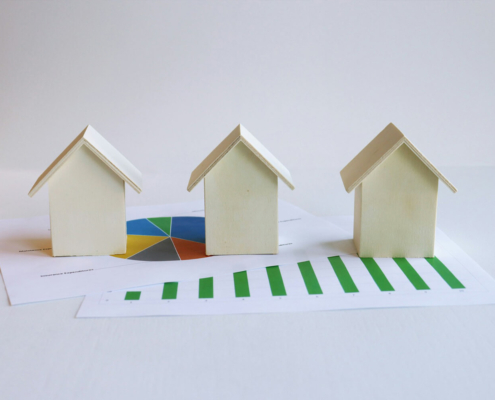Talk to an Expert!
Want to to learn more or see how if applies to your project? Let’s Connect!
The Consequences of Overleveraging a Real Estate Investment
Real estate investing is often celebrated as one of the most reliable paths to building wealth. One of the key reasons? Leverage. By using borrowed money to acquire property, investors can amplify their returns while preserving their personal capital. However, as with any powerful financial tool, misuse can lead to disaster.
Overleveraging a real estate investment—taking on too much debt relative to the income the property produces—can sink even the most promising portfolio. In this post, we’ll explore what overleveraging is, how it happens, its short- and long-term consequences, and the strategies you can use to avoid it.
What Is Overleveraging in Real Estate?
In the simplest terms, overleveraging occurs when an investor borrows more money than the property or portfolio can safely support. While leverage allows for increased purchasing power and the potential for higher returns, overdoing it means you’re too reliant on borrowed funds—leaving little room for error.
In technical terms, overleveraging often shows up in:
- High loan-to-value (LTV) ratios (above 80%)
- Weak debt service coverage ratios (DSCRs) (below 1.2x)
- Excessive debt-to-income (DTI) ratios (over 40%)
When real estate markets are booming, aggressive borrowing might seem like a savvy move. But when interest rates rise, vacancies increase, or property values fall, overleveraged investors can quickly find themselves underwater—owing more than their properties are worth.
Common Causes of Overleveraging
1. Aggressive Growth Mindset
A desire to scale quickly can lead to risky financing decisions. Investors often get caught in a “growth trap,” buying multiple properties on borrowed funds without a stable financial foundation.
Example: An investor buys four properties within 18 months using 90% LTV loans. If rental income dips due to vacancies or maintenance issues, they might struggle to cover all mortgage payments.
2. Overconfidence in Market Appreciation
Speculative investors sometimes base their strategy on future appreciation rather than present cash flow. When markets cool, this leaves them vulnerable.
Example: A property purchased for $400,000 with the expectation it will be worth $500,000 in two years may not appreciate—or may even lose value. If the investor needs to refinance or sell, they’re exposed.
3. Underestimating Operating Expenses
Investors who ignore hidden costs like property taxes, insurance, CapEx, or vacancies may find themselves overleveraged without realizing it.
4. Using Variable Interest Rate Loans
Adjustable-rate mortgages (ARMs) might offer lower initial payments, but can spike later. If rates rise sharply and income remains flat, the property could become a liability.
Signs You’re Overleveraged
Think you might be skating on thin ice? Watch for these red flags:
- Your cash flow is break-even or negative month after month
- You’re relying on credit cards or personal loans to cover maintenance or mortgage shortfalls
- You lack reserves for unexpected expenses like vacancies or emergency repairs
- Your debt-to-income ratio exceeds 40%
- You’re counting on refinancing or appreciation to stay afloat
The Financial Consequences of Overleveraging
1. Negative Cash Flow
If your monthly income doesn’t cover the mortgage, insurance, taxes, and upkeep, you’re bleeding cash. Even a modest shortfall of $200/month per property can add up quickly across a portfolio.
Example: With five properties each losing $200/month, that’s a $12,000 annual hit to your finances.
2. Foreclosure Risk
When income can’t cover debt obligations, and reserves are depleted, foreclosure becomes a real possibility. This doesn’t just lead to the loss of property—it severely damages your credit and future borrowing potential.
3. Underwater Properties
Falling property values combined with high LTV loans can put you in a negative equity position. This makes refinancing difficult and selling nearly impossible without bringing cash to the table.
4. Difficulty Securing Future Financing
Lenders scrutinize DTI ratios and creditworthiness. If your existing debts consume too much of your income, expect to be declined or offered loans with unattractive terms.
5. Investor Burnout
The emotional toll of managing overleveraged properties cannot be overstated. Constant stress, financial anxiety, and the inability to grow your business can lead to burnout or even exit from real estate altogether.
Long-Term Portfolio Risks
Overleveraging doesn’t just jeopardize one property—it can compromise your entire investment strategy.
1. Reduced Agility
With limited cash flow and capital reserves, you’re less able to pounce on opportunities or weather a downturn. Flexibility is key in an industry with so many moving parts.
2. Forced Liquidation
You might be forced to sell properties at a loss just to cover loan obligations. This shrinks your portfolio, reduces rental income, and resets your progress.
3. Inflexible Exit Strategies
If your endgame is to sell, refinance, or 1031 exchange into a better asset, being overleveraged limits those options. Lenders may refuse a refi, or you may lack the equity needed for a tax-efficient sale.
How to Avoid Overleveraging
The good news? Overleveraging is preventable with the right approach.
1. Set Conservative Loan-to-Value Targets
Keep LTV ratios under 75% where possible. The extra equity provides a buffer against price drops and improves your chances of refinancing when needed.
2. Stress-Test Your Portfolio
Simulate what would happen to your cash flow if:
- Your property sat vacant for three months
- Your loan interest rate increased by 2%
- You faced a $5,000 roof repair
If you can’t withstand those stressors, your leverage is too high.
3. Build and Maintain Cash Reserves
A strong reserve fund (ideally 3–6 months of expenses per property) gives you breathing room and protects against forced selling or short-term financing traps.
4. Prioritize Cash Flow Over Appreciation
Buy properties that pay for themselves from Day 1. Appreciation is a bonus—not a guarantee.
Example: A $200/month positive cash flow can provide $2,400/year in margin. Across 5 properties, that’s $12,000/year you can use for reserves or debt paydown.
5. Avoid High-Risk Financing
Be cautious of interest-only loans, hard money loans with balloon payments, or no-money-down deals unless you have a clear exit strategy and cash cushion.
6. Diversify Across Asset Classes and Locations
A diverse portfolio is more resilient. Consider mixing:
- Single-family homes
- Small multifamily units
- Commercial or mixed-use properties
- Different markets (urban vs. suburban)
7. Use Fixed-Rate Loans When Possible
Predictable debt payments make long-term planning easier and insulate your portfolio from interest rate volatility.
8. Review Your Portfolio Quarterly
Don’t wait for a crisis to spot overleveraging. Regular reviews of your DSCR, LTV, and DTI can help you course-correct early.
Final Thoughts: Leverage With Intention, Not Emotion
Leverage is like fire—it can cook your dinner or burn your house down. Used wisely, it accelerates growth and wealth. But when used recklessly, it magnifies every weakness in your investment strategy.
If you’re pursuing financial freedom through real estate investing, remember that it’s a long game. Sustainable growth, healthy cash flow, and a strong financial foundation are more important than rapid expansion driven by debt.
Smart Leverage Starts With Smart Funding
If you’re ready to grow your real estate portfolio without falling into the overleveraging trap, Investors Choice Funding is here to help. Our team specializes in sustainable financing solutions tailored to real estate investors. Whether you’re scaling your holdings or refinancing a high-interest loan, we’ll help you structure your deals for long-term success.







